This handy Math in Focus Grade 7 Workbook Answer Key Cumulative Review Chapters 6-8 detailed solutions for the textbook questions.
Math in Focus Grade 7 Course 2 B Cumulative Review Chapters 6-8 Answer Key
Concepts and Skills
Tell whether each pair of angles is supplementary, complementary, or neither. (Lesson 6.1)
Question 1.
m∠1 = 18° and m∠2 = 82°
Answer:
Given each pair of angles are complementary angles.
Explanation:
The sum of two angles is equal to 90° is called complementary angles. In the given figure if we sum up both the angles that is 18°+ 82°we get a 90° angle.
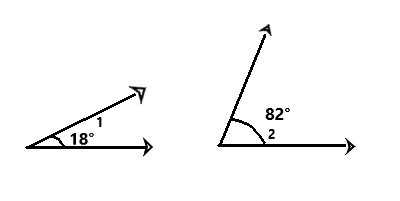
Question 2.
m∠3 = 103° and m∠4 = 77°
Answer:
Given each pair of angles are supplementary angles.
Explanation:
Supplementary angles are those angles that sum up to 180°.
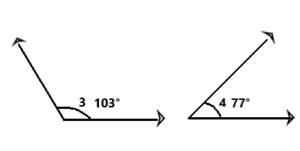
Question 3.
m∠5 = 95° and m∠6 = 85°
Answer:
Given each pair of angles are supplementary angles.
Explanation:
Supplementary angles are those angles that sum up to 180°. Therefore add 95° and 85° then we get 180°.
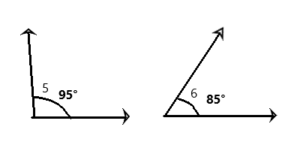
Question 4.
m∠7 = 21° and m∠8 = 69°
Answer:
Given each pair of angles are complementary angles.
Explanation:
The sum of two angles is equal to 90° is called complementary angles. In the given figure if we sum up both the angles that are 21°+ 69°we get a 90° angle.
Find the measure of each numbered angle. (Lessons 6.1, 6.2)
Question 5.
\(\overleftrightarrow{P R}\) is a straight line.
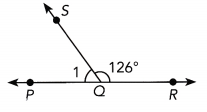
Answer:
54°
Explanation:
Given, ∠SQR = 126°
∠QPR = 180°
∠PQS = 1
Here we need to calculate the numbered angle.
To find that we need to subtract ∠QPR from ∠SQR
∠1 = 180°-126°
∠1 = 54°
Hence the numbered angle is 54°
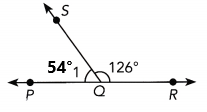
Question 6.
\(\overleftrightarrow{P R}\) is a straight line.
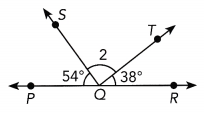
Answer:
88°
Explanation:
The straight-line QPR has 180°.
Given, ∠PQS = 54°
∠QTR = 38°
∠SQT is numbered angle that is ∠2
Now we need to calculate the numbered angle
Therefore QPR = ∠PQS + ∠QTR + ∠2
180°= 54°+38°+ ∠2
180°= 92°+ ∠2
180°-92° = ∠2
∠2 = 88°
Question 7.
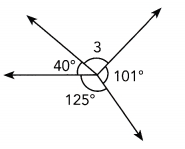
Answer:
The numbered angle 3 is 94°
Explanation:
The sum of angles around a point is 360°
40°+125°+101°+3=360°
3= 360°-40°-125°-101°
3= 360° – 266°
3 = 94°
Hence the numbered angle 3 is 94°
Question 8.

Answer:
36°
Explanation:
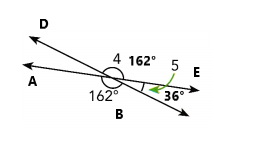
The sum of angles around a point is 360°
When two lines cross the angles are opposite to each other. Therefore opposite angles are equal to each other.
The angle ∠ABC and ∠DBE are opposite to each other. So ∠ABC = ∠DBE
Given, ∠ABC = 162°, ∠DBE means the numbered angle 4 is also 162°
Now we need to calculate the numbered angle 5
To calculate the angle 5 we need to add ∠ABC + ∠DBE+ 5 = 360°
162°+162°+∠5 = 360°
324°+ ∠5 =360°
∠5 = 360°-324°
∠5 = 36°
\(\overleftrightarrow{M N}\) is parallel to \(\overleftrightarrow{P Q}\). Find the measure of each numbered angle. (Lesson 6.3)
Question 9.
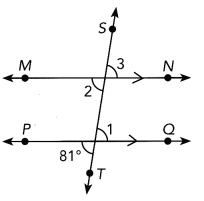
Answer:
m∠1 = 81°
Vertical ∠s
Question 10.
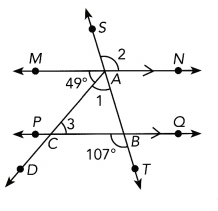
Answer:
m∠3 = 49°
Alternate interior ∠s
Find the measures of ∠1 and ∠2 in each diagram. (lesson 6.4)
Question 11.
Triangle ABC is an isosceles triangle.
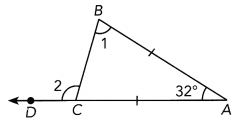
Answer:
32°
Explanation:
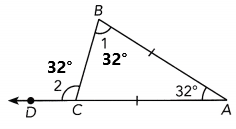
1+32°+x =180°
1+x° = 180°-32°
1+x°= 148°
1+x°+2 = 180°
148° +2 = 180°
2 = 180°-148°
2 = 32°
1+x°= 148°
32°+x°= 148°
x°=148°-32°
x°= 116°
1=148-116
1=32°
Question 12.
\(\overleftrightarrow{P R}\) is a straight line.

Answer:
110°+1 = 180°
1 = 180°-110°
1 = 70°
Use the given Information to construct each polygon.
Construct triangle ABC with sides AB = 5.8 cm, BC = 6.6 cm, and AC = 4.5 cm. (Lessons 7.1, 7.2, 7.3)
Step 1:
we are given
AB = 5.8
BC = 6.6
AC = 4.5
Step 2:
Use a ruler to draw the segment 66 cm long. LabeL its endpoints by B and C.

Step 3:
Because AB = 5.8 cm, use the ruLer to set the compass to a radius of 5.8 cm Then using A as center draw an arc of radius 5.8 cm above \(\overline{B C}\).

Step 4:
Because AC = 4.5 cm, use the ruler to set the compass to a radius of 4.5 cm. Then using G as center draw an arc of radius 4.5 cm that intersects the first arc. Label the intersection as A.

Step 5:
Use the ruler to draw \(\overline{A B}\) and \(\overline{A C}\)
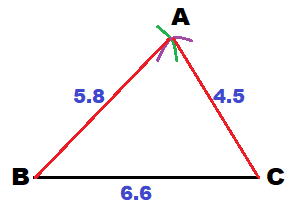
a) Measure the angles of the triangle.
Answer:
m∠A ≈ 79°
m∠B ≈ 42°
m∠C ≈ 59°
b) Use a compass and straightedge to bisect angle B.
Answer:

c) Use a compass and straightedge to construct the perpendicular bisector of AB.
Answer:

d) The two bisectors intersect at a point D, label D in your construction.
Answer:

e) Measure the distances BD and CD.
Answer:
BD ≈ 3.2 cm
CD ≈ 3.8 cm
Question 14.
Construct quadrilateral PQRS with PQ = PR = 7.8 cm, PQ ||SR, m∠PQR = 73°, and RS = 4 cm. (Lessons 7.1, 7.2, 7.4)
Step 1:
We are given
PQ = PR = 7.8
PQ || SR
m∠PQR = 73°
RS = 4
Step 2:
Sketch the quadrilateral

Step 3:
First we construct △PRQ using the side-side-angle method.
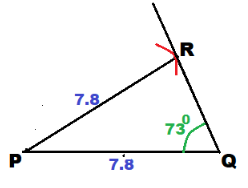
Step 4:
Determine m∠RPQ
m∠RPQ + 2.73° = 180°
m∠RPQ = 180° – 146°
m∠RPQ = 34°
Step 5:
As PQ || SR, we have
m∠SRP = m∠RPQ = 34°
Step 6:
We construct △PRS, using the side-angle-side method.
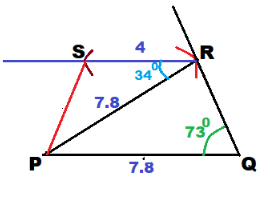
a) Measure the length of PS.
Answer:
PS ≈ 5 cm
b) Use a compass and straightedge to construct the angle bisector of ∠S.
Answer:

c) Use a compass and straightedge to construct the perpendicular bisector of \(\overline{P Q}\).
Answer:
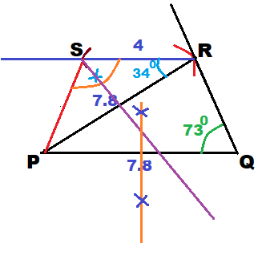
d) Label the point where the angle bisector and perpendicular bisector intersect as W.
Answer:
Solve. Show your work. (Lesson 7.5)
Question 15.
Jacob builds a model plane that is 800 millimeters long. If the actual plane is 40 meters, what is the scale of the model? (10 mm = 1 cm)
Answer:
We are given
Length on the plane: 800 mm
Actual length: 40 m
Determine the scale of the model:
\(\frac{\text { Length on the plane }}{\text { Actual length }}=\frac{800 \mathrm{~mm}}{40 \mathrm{~m}}=\frac{80 \mathrm{~cm}}{4,000 \mathrm{~cm}}=\frac{1}{50}\)
= \(\frac{1}{50}\)
Question 16.
The scale of a map is 1 : 1,500. If a square piece of land measures 4 inches on each side on the map, find the actual area of this piece of land to the nearest tenth of an acre. (1 acre = 43,560 ft2)
Answer:
We have:
Step 1:
Map length : Actual length = 1 in. : 1,500 in.
Map area: ActuaL area = 1 in.2 : 1, 5002 in2
Step 2:
Let y represent the actual area of the piece of land in square inches.
Step 3:
Write a proportion: \(\frac{\text { Piece area on map }}{\text { Actual area of piece }}=\frac{1}{2,250,000}\)
Step 4:
Substitute:
\(\frac{4^{2}}{y}=\frac{1}{2,250,000}\)
Step 5:
Write the cross products:
y = 16.2,250,000
Step 6:
Simplify
y = 36,000,000 in2
Step 7:
Convert to acres:
1 acre = 43,560 ft = 43. 560. 122 = 6. 272, 640 in2
\(\frac{36,000,000}{6,272,640}\) ≈ 5.7 acres
= 5.7 acres
Match each solid with its net. (Lesson 8.1)
Question 17.

Answer:
The net of a cone consists of a circle and a sector of a circle.
The net b) does not consists a sector of circle, so we eliminate it
The net a) also doesn’t contain a sector of circle, therefore we eliminate it
The net d) is an ellipse sector, not a circle sector, so we eliminate it
The correct answer is (c)
Question 18.

Answer:
The net of a trianguLar prism contains 4 triangles.
The net b) contains 3 triangles and a rectangle, not 4 triangles, so we eliminate it
The net c) contains 4 triangles and a rectangle, not 4 triangles, so we eliminate it
The net d) contains 3 triangles, not 4 triangles, so we eliminate it
The correct answer is (a)
For each solid, sketch and describe the shape of the cross section formed when a plane slices the solid in the direction indicated. (Lesson 8.1)
Question 19.
A cube of length 6 centimeters perpendicular to a base and parallel to two opposite faces.

Answer:
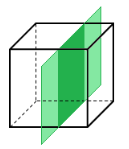
A cross-section perpendicular to a base and parallel to two opposite faces can be drawn starting with a point for example on one of the edges of the top face. We draw a parallel line to two of the edges on the top face other than the one opposite to the one containing the initial point From the ends of the line we draw two vertical lines to the vertical edges. We join the ends of these two paralLels.
Question 20.
A cylinder of radius 3 centimeters parallel to its bases.

Answer:

A cross section parallel to its bases has the shape of a circle of radius 3:
Question 21.
A right triangle base prism parallel to its bases.

Answer:
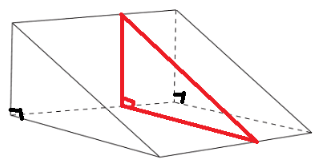
A cross-section paralleL to its bases can be drawn starting with a point for example on one of the edges other than the bases We draw a parallel line to each of the corresponding edges on the bases. We join the ends of these two parallels.
Question 22.
Copy and complete the table. Use 3.14 as an approximation for π. (Lesson 8.2)

Answer:
Step 1:
We are given the cylinder:
V = 942
h = 12
Step 2:
Determine the radius r:
V = πr2h
942 ≈ 3.14 · r2 · 12
942 = 37.68 r2
r2 = \(\frac{942}{36.68}\)
r2 = 25
r = \(\sqrt{25}\)
r = 5 ft
Step 3:
Determine the diameter:
d = 2 · r = 2 · 5 = 10 ft
Step 4:
Determine the total surface area:
S = 2πr2 + 2πrh
= 2π · 52 + 2π · 5 · 12
= 50π + 120π
= 170π
≈170 · 3.14
= 533.8 ft2
Step 5:
We are given the cylinder:
V = 879.2
d = 10
Step 6:
Determine the radius:
r= \(\frac{d}{2}\) = \(\frac{10}{2}\) = 5 cm
Step 7:
Determine the height:
V = πr2h
879.2 ≈ 3.14 · 52 · h
879.2 = 78.5h
h = \(\frac{879.2}{78.5}\) = 11.2cm
Step 8:
Determine the total surface area:
S = 2πr2 -1- 2πrh
= 2π · 52 + 2π · 5 · 11.2
= 50π + 112π
= 162π
≈ 162 · 3.14
= 508.7cm2
Step 9:
We are given the cylinder:
r = 4
S = 251.2
Step 10:
Determine the height:
S = 2πr2 + 2πrh
251.2 ≈ 2 · 3.14 · 42 + 2 · 3.14 · 4 · h
251.2 = 100.48 + 25.12h
251.2 – 100.18 = 100.48 + 25.12h – 100.48
150.72 = 25.12h
h = \(\frac{150.72}{25.12}\)
h = 6 m
Step 11:
Determine the volume:
V = πr2h ≈ 3.14 · 42 · 6 ≈ 301.4 m3
Step 12:
Determine the diameter:
d = 2r = 2 · 4 = 8 m
Step 13:
Complete the table

Find the exact surface area of each solid cone. (Lesson 8.3)
Question 23.
A cone with radius of 8.7 meters and a slant height of 12.8 meters.
Answer:
We are given the cone:
r = 8.7
l = 12.8
Use the formula for the cone’s surface area:
S = πr2 + πrl
Substitute r, l to find the exact surface area:
= π · 8.72 + π · 8.7 · 12.8
= 75.69π + 111.36π
= 187.05 π m2
Question 24.
A cone of diameter 16.8 centimeters and slant height 20.6 centimeters.
Answer:
We are given the cone:
d = 16.8
l = 20.6
First we determine the radius:
r = \(\frac{d}{2}\) = \(\frac{16.8}{2}\) = 8.4
Use the formuLa for the cones surface area:
S = πr2 + πrl
Substitute r, ito find the exact surface area:
= π · 8.42 + π · 8.4 · 20.6
= 70.56π + 173.04π
= 243.6π cm2
Find the volume of each solid. Use 3.14 as an approximation for π. Round your answers to the nearest tenth when you can. (Lessons 8.3, 8.4)
Question 25.
A square pyramid with a height of 13 centimeters and a base that is 8 centimeters on each edge.
Answer:
Use the formula:
V = \(\frac{1}{3}\) Bh
Substitute for B and h.
= \(\frac{1}{3}\) · (82) · 13
Multiply and round:
≈ 277.3 cm3
= 277.3 cm3
Question 26.
An octagonal pyramid with a height of 8.2 inches and a base area of 34.5 square inches.
Answer:
Use the formula:
V = \(\frac{1}{3}\) Bh
Substitute for B and h.
= \(\frac{1}{3}\) · 34.5 · 8.2
Multiply and round:
= 94.3 in3
Question 27.
A cone with a radius of 6.5 centimeters and a height of 14 centimeters.
Answer:
We are given the cone:
r = 6.5
h = 14
Use the formula for the cone’s volume to find the volume:
V = \(\frac{1}{3}\)πr2h
≈ \(\frac{1}{3}\) · 3.14 · 6.52 · 14
≈ 619.1 cm3
= 619.1 cm3
Question 28.
A cone with a diameter of 24.6 feet and a height of 18.5 feet.
Answer:
We are given the cone:
d = 24.6
h = 18.5
Determine the radius:
r = \(\frac{d}{2\) = \(\frac{24.6}{2}\) = 12.3 ft
Use the formula for the cone’s volume to find the volume:
V = \(\frac{1}{3}\)πr2h
≈ \(\frac{1}{3}\) · 3.14 · 12.32 · 18.5
≈ 2,929.5 ft3
= 2,929.5 ft3
Question 29.
A sphere with a radius of 9.6 feet.
Answer:
We are given the sphere:
r = 9.6
Use the formula for the volume of a sphere:
V = \(\frac{4}{3}\)πr3 ≈ \(\frac{4}{3}\) · 3.14 · 9.63
Multiply:
= 3,704.094…
Round to the nearest tenth:
≈ 3,704.1 ft3
= 3,704.1 ft3
Question 30.
A sphere with a diameter of 39.8 centimeters.
Answer:
We are given the sphere:
d = 39.8
Determine the radius of the sphere:
r = \(\frac{d}{2}\) = \(\frac{39.8}{2}\) = 19.9 cm
Use the formula for the volume of a sphere:
V = \(\frac{4}{3}\)πr3 ≈ \(\frac{4}{3}\) · 3.14 · 19.93
Multiply:
= 32,993.4411….
Round to the nearest tenth:
≈ 32,993.4 cm3
= 32,993.4 cm3
Problem Solving
Find the value of each variable. (Chapter 6)
Question 31.

Answer:
x°=37°
2x=74°
Explanation:
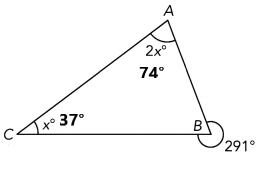
A 360-degree angle is a complete angle of a point.
∠ABC = 360°-291°
∠ABC = 69°
∠ABC+BCA+CAB = 180°
69°+x°+2x°=180°
3x°+69=180°
3x°=180-69
3x°=111
x°=111÷3
x°=37°
2x°=74°
Question 32.
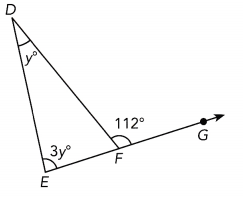
Answer:
Explanation:
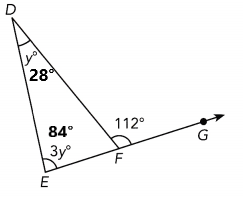
∠DFE = 180°-112°
∠DFE = 68°
y°+3y°+ 68°= 180°
4y°+68° = 180°
4y°= 180°- 68°
4y°=112
y°=112÷4
y°= 28°
3y°= 84°
Question 33.
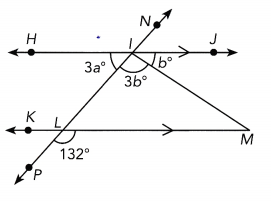
Answer:
Alternate exterior ∠s:
m∠HIN = 132°
VerticaL ∠
m∠HIN = 3b° + b°
Substitute and simplify:
132 = 4b
Divide by 4:
\(\frac{132}{4}\) = \(\frac{4b}{4}\)
Simplify
b = 33
Straight ∠:
3a° + 3b° + b° = 180°
Substitute and simplify:
3a ° + 4b° = 180°
3a + 4 · 33 = 180
3a + 132 = 180
Subtract 132 from both sides:
3a + 132 – 132 = 180 – 132
Simplify
3a = 48
Divide by 3
\(\frac{3a}{3}\) = \(\frac{48}{3}\)
Simplify
a = 16
a = 16; b = 33
Question 34.
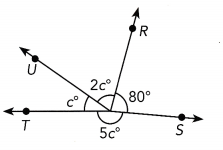
Answer:
35°
Explanation:
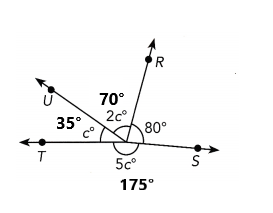
∠PTU = c°
∠PRS = 80°
∠PUR = 2c°
∠TPS = 5c°
The sum of angles around the point is 360°
Sum of ∠PTU+ ∠PRS + ∠PUR + ∠TPS = 360°
c°+80°+2c°+5c° = 360°
8c° + 80° = 360°
8c° = 360°- 80°
8c° = 280°
c° = 280÷8
c°= 35°
2c°= 70°
5c°= 175°
Solve. Show your Work.
Question 35.
Segment AB is parallel to segments CD and EF. Segment BC is parallel to segment ED. Find the measure of ∠ABC. (Chapter 6)
Answer:
BC || ED Given
Question 36.
The diagram shows a triangular pin. Triangle ABC is an isosceles triangle. Line BD is parallel to line EF. m∠AEF = 40° and m∠DBC = 27°.
Find the measures of ∠EBD and ∠BAC. (Chapter 6)
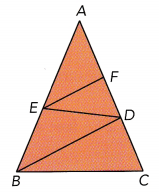
Answer:
We are given:

Corresponding ∠s:
m∠EBD = 40°
Determine m∠ABC:
m∠ABC – m∠EBD + m∠DBC
= 40° – 27°
= 67°
△ABC isosceles:
m∠ACB = m∠ABC = 67°
Sum of ∠s in a triangle:
m∠BAC + m∠ACB + m∠ABC = 180°
Substitute:
m∠BAC + 67° + 67° = 180°
Simplify:
m∠BAC + 134° = 180°
We subtract 134° from both sides:
m∠BAC + 134° – 134° = 180° – 134°
Simplify:
m∠BAC = 46°
m∠EBD = 40°
m∠BAC = 46°
Question 37.
X, Y, and Zare the location of three manufacturing factories linked by three straight roads as shown in the diagram. A water pipe will go from Factory Y, and will be equidistant from the two roads linking Factory X and Factory Z to Factory Y. (Chapter 7)
a) Construct triangle XYZ to represent the locations of the three factories using a scale of 1 centimeter to 100 meters.
Answer:


b) Using a compass and straightedge only, construct the path of the water pipe.
Answer:
The Line whose points are equidistant from \(\overline{Y^{\prime} X^{\prime}}\) and \(\overline{Y^{\prime} Z^{\prime}}\) is the angle bisector of ∠Y’. We construct it:
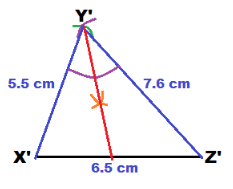
c) The water department needs to build a temporary construction worksite that must be equidistant from Factory Y and Factory Z and at a distance of 400 meters from Factory X. Label the position of the construction worksite to be set up in your diagram as point W.

Answer:
The tine whose points are equidistant from Y’ and Z’ is the perpendicular bisector of \(\overline{Y^{\prime} Z^{\prime}}\). We construct it and label by W its intersection with the angle bisector from part b):
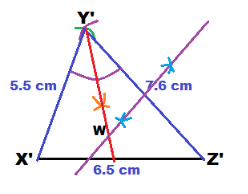
Question 38.
A model of a gym uses a scale of 1 : 12. The actual gym will be a rectangular prism. It will be 69.6 feet long, 54 feet wide, and 22.8 feet high. Find, in cubic feet, the volume of the model of the gym. (Chapters 7, 8)
Answer:
85691 cubic feet
Explanation:
The actual gym is a rectangular prism.
Given the length of a rectangular prism is 69.6 feet
Width = 54 feet
Height = 22.8 feet
The voulme of a rectangular prism is = Length × Width × Height
Volume = 69.6 × 54 × 22.8
Volume = 85691 cubic feet
Question 39.
Mrs. Sullivan buys a 5-liter bottle of apple juice. She can either use cylindrical glass A or cylindrical glass B to serve the apple juice. Use 3.14 as an approximation for π. (1,000 cm3 = 1 L) (Chapter 8)
We are given:
dA = 6
hA = 9
dB = 5
hB = 12
a) What is the volume of glass A?
Answer:
Determine the radius of glass A:
rA = \(\frac{d_{A}}{2}\) = \(\frac{6}{2}\) = 3 cm
Determine the volume of glass A
VA = πrA2hA ≈ 3.14 · 32 · 9 = 254.34 cm3
b) How many glasses of apple juice can she serve if she uses glass A?
Answer:
Determine the number of glasses A:
\(\frac{5 \cdot 1,000}{254.34}\) = \(\frac{5,000}{254.34}\) ≈ 19 glasses
c) What is the volume of glass B?
Answer:
Determine the radius of glass B:
rB = \(\frac{d_{B}}{2}\) = \(\frac{5}{2}\) = 2.5 cm
Determine the volume of glass B
VB = πrB2hB ≈ 3.14 · 2.52 · 12 = 235.5 cm3
d) How many glasses of apple juice can she serve if she uses glass B?
Answer:
Determine the number of glasses B:
\(\frac{5 \cdot 1,000}{235.5}\) = \(\frac{5,000}{235.5}\) ≈ 21 glasses
e) If Mrs. Sullivan sells one glass of apple juice for $1.80, what is the maximum amount of money she can collect?
Answer:
21 · 1.80 = 37.80